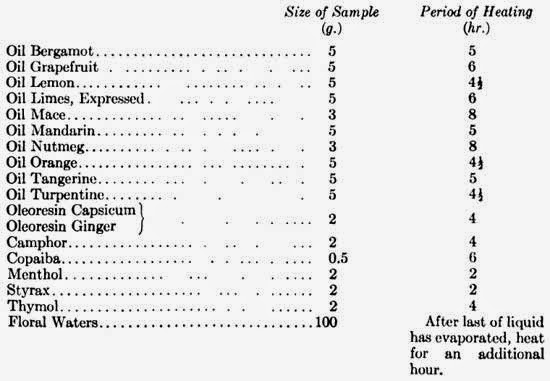9. EVAPORATION RESIDUE
An important criterion of purity is the
evaporation residue; i.e., the percentage of the oil which is not volatile at 100o.
A determination of the evaporation residue is
of special value in the case of the citrus oils; a low value for an expressed oil
suggests the possibility of the addition of terpenes, or other volatile constituents;
a high value may indicate the addition of foreign material, such as, rosin,
fixed oils, or high boiling sesquiterpenes. In the case of rectified oils such as
turpentine, a high value may indicate improper or lack of rectification, or polymerization
due to age or improper storage. In the case of certain solids, such as camphor,
thymol, or menthol, a high evaporation residue will indicate insufficient purification.
It is important to study the odor of an oil as
it volatilizes during the heating. Often "by-notes" of foreign low boiling
adulterants or contaminants may be discovered. The odor of the final residue while
still hot should also be carefully studied for the addition of high boiling adulterants,
such as cedarwood.
The consistency of the residue, both when hot
and cool, and the color sometimes indicates the presence of particular
adulterants. For example, an orange oil, which has a brittle residue instead of
the usual soft waxy residue, should be carefully investigated for rosin.
Acid numbers and saponification numbers may be
determined on suspicious residues: rosin usually raises the acid number considerably;
fixed oils raise the saponification number.
---------------------------------
48 For oils containing mostly high boiling constituents (such as cassia and bay), use an air-cooled condenser.
The fact that essential oils are complex mixtures
makes an exact determination of the nonvolatile residue very difficult. "Constant
weight" cannot conveniently be attained because of the fact that waxes and
other high boiling nonvolatile material tend to retain or "fix" some of
the lower boiling constituents. "The United States Pharmacopoeia" defines
constant weight as the value obtained when "two consecutive weighings do not
differ by more than 0.1 per cent, the second weighing following an additional hour,
of drying."49 Even after "constant weight," according
to this definition, has been attained, further prolonged heating will give much
lower results. Hence, a certain standardization of technique becomes necessary.
Procedure: Weigh accurately (to
the closest milligram) a well cleaned Pyrex evaporating dish that has been permitted
to stand in a desiccator for 30 min. To this tared dish add the requisite amount
of oil or solid (weighed to the closest centigram) and heat on a steam bath for
the prescribed length of time. Then permit the evaporating dish to cool to room
temperature in the desiccator and weigh (to the closest milligram). Calculate
the nonvolatile residue obtained, the so-called "evaporation residue,"
and express as a percentage of the original oil.
It is well to bear in mind that the size, shape,
aiid composition of the evaporating dish employed in such a determination, as
well as the size of sample and time of heating, will influence the analytical
result obtained.
Flat bottom evaporating dishes of Pyrex glass
are very satisfactory; they offer the further advantage of more easily permitting
an observation of the color and opacity of the residue. Conventional Pyrex evaporation
dishes, 80 mm. in diameter and 45 mm. deep, are to be recommended. The use of such
dishes tends to minimize the formation of polymerization products in most cases.
Certain exceptional products will require
special treatments, however; evaporation residues on such materials as diacetyl
are meaningless because of the rapid formation of polymerization products unless
the determinations are carried out in vacuum with the application of little or no
heat.
In evaluating oleoresins, evaporation residues
should also be determined. Here it is best to express the results as "loss
of weight on heating” The analytical results obtained will include the loss of
volatile solvent as well as the loss of part of the naturally occurring essential
oil. An abnormally high value often indicates the incomplete removal of the volatile
solvent used in the manufacture of the oleoresin.
------------------------------
49
Twelfth Revision,
3. The Thirteenth Revision, 7, limits the difference to not more than 0.05%.



0 Comment:
Post a Comment